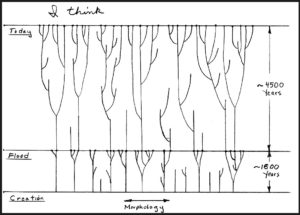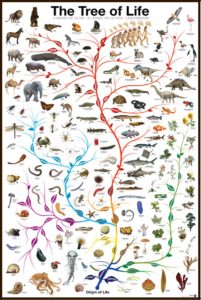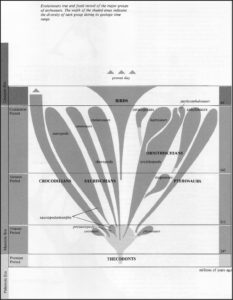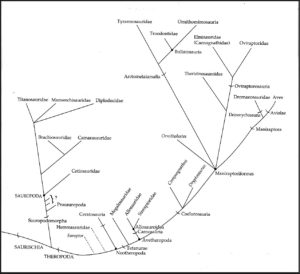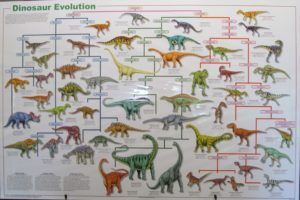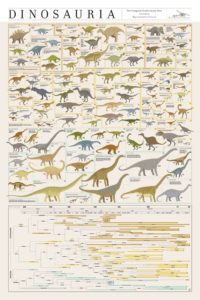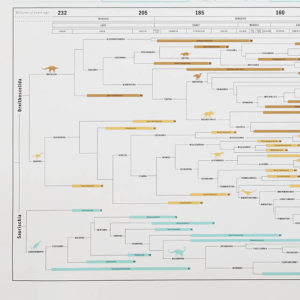INTRODUCTION:
It seems that everyone with an interest in dinosaurs would like to understand their classification. That is, how are they sorted out according to some plan or process? The conventional or secular view is that all dinosaurs were the result of a naturalistic evolutionary process of macro changes from a common ancestor over a period of millions of years. The biblical creationist view is that dinosaurs were created in the beginning by God according to kinds as described in the Bible. The secular view looks forward to the time when scientists can develop a proposal for a complete continuity of evolutionary transitions of all dinosaur species from that common ancestor.
On the other hand, creationists are looking forward to the time when discontinuities between dinosaur traits can be sufficiently discovered in order to approximate the original created dinosaur kinds. For the creationist, “kind” is never the same as species and is often placed at about the family Linnaean taxonomic level. Most creationists believe all dinosaur fossils are the result of the unique cataclysmic conditions of the Genesis Flood at the time of Noah, about 4,500 years ago. According to the Bible, the Flood occurred about 1,600 years after the creation, the subsequent fall of man, and institution of the curse on creation by God. It follows that the basic kinds of dinosaurs were the result of God’s work at creation; and the many variations in dinosaurs, found through inspection of their remains in the sediments, are the result of what happened to the dinosaurs over the 1,600 years from fall to Flood.
Back in the 1700s biologist Carl Linnaeus developed a classification system for naming animal and plant life. Linnaeus was a biblical creationist and saw order in nature while believing that the Bible was literally true. He introduced the familiar system of scientific naming called the “binomial nomenclature” with genus name followed by species name. An example of this for dinosaurs would be Tyrannosaurus rex. In this system the two names are always italicized with the genus name starting with a capital letter and the species with lower case. His complete biological classification system for animals, starting with the largest grouping and dropping down to the most specific, went like this: Kingdom-Phylum-Class-Order-Family-Genus-Species. Many secularists and creationists have used this system over the last two centuries as the foundation for their classification of animals including the dinosaurs.
Evolutionists early on, especially after Darwin’s book was published in 1859, began transforming the creationist Linnaean classification system from being a sorting system of God’s created kinds into a “tree of life” suggesting continuity among all living things. While common ancestors are fundamental in all evolutionary classification charts, creationists see the depiction of the relationships for life as more like an orchard, a garden, or a field of bushes. The fundamental difference in these perspectives can be seen in the two images that follow.
Figure 1: Creationist J.D. Mitchell’s Animal Lifeform Classification Diagram-An Orchard
Figure 2: Typical Evolutionary Tree of Life-Common Ancestor Emphasis
A commonality between the secular and creationist views is that proponents in both camps consistently promote their views regarding dinosaur classification to the general public at the genus taxonomic level. The genus level is where we learn the names of dinosaurs like Tyrannosaurus, Stegosaurus, Brachiosaurus, Edmontosaurus, Triceratops, etc. But, a closer look into dinosaur classifying efforts reveals a lack of consistency within both the secular and the creationist factions. In these two articles (Part 1 and Part 2) I will attempt to shine some light on this lack of consistency. The purpose of this effort is to impart knowledge, not necessarily to solve the classification problems to anyone’s satisfaction. The means for this effort will be through an inspection of a number of published charts and posters. In this Part 1 we will focus on some secular ideas for dinosaur classification and then, in article Part 2, we will look at some creationist ideas.
A. SECULAR DINOSAUR CLASSIFICATION—Helen J. McGinnis AND CARNEGIE MUSEUM OF NATURAL HISTORY
A good representation of the secular idea for dinosaur classification in 1982 is seen in the three charts (Figures 3-5) shown next which were based on displays and publications from the Carnegie Museum of Natural History in Pittsburgh, PA.
Figure 3: McGinnis 1982 Archosaur and Dinosaur Evolutionary Tree
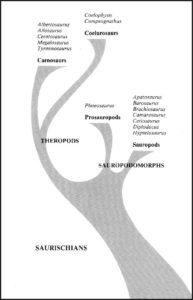 Figure 4: McGinnis 1982 Saurischian Dinosaurs
Figure 4: McGinnis 1982 Saurischian Dinosaurs
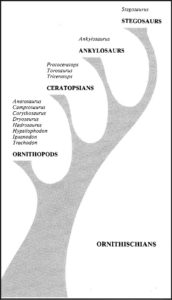 Figure 5: McGinnis 1982 Ornithischian Dinosaurs
Figure 5: McGinnis 1982 Ornithischian Dinosaurs
Notice that these charts emphasize North American dinosaur genera. According to these charts the dinosaurs came into begin about 220 million years ago and lasted until 65 million years ago, a period of 155 million years of evolution. There are two orders of dinosaurs depicted, the Saurischians and the Ornithischians. The Saurischians have sub groups called Sauropodomorphs and Theropods, and those two groupings are broken into four infraorders called Sauropods, Prosauropods, Coelurosaurs, and Carnosaurs. There are fifteen dinosaur genus names listed for the Saurischians.
The Ornithischians have four sub groups named Ornithopods, Ceratopsians, Ankylosaurs, and Stegosaurs and those four groupings are not broken into infraorders as were the Saurischians. There are thirteen dinosaur genus names listed for the Ornithischians. Neither order of the Carnegie dinosaurs are broken down to the species level.
The Carnegie classification was arrived at from evaluations of similarities found in the bones and teeth of the various fossil remains, assuming that evolution from a common ancestor occurred sometime in the past. There is no mention of cladistics being used to arrive at the classifications with dinosaur teeth being a most important characteristic for evaluation to one group or another. Notice that the birds are shown on the chart in Figure 3 without any proposed evolutionary connection to a common ancestor.
CLADISTICS TAKES OVER:
All of the following secular dinosaur classification posters are based on cladistical analysis, and the previous Linnaean foundation has been modified or discarded. I think this method change was as a result of the large number of dinosaurs named in the late 20th century due to an expansion of discoveries in Morocco, Mongolia, Argentina, China, and other locations around the world. By the 1990s especially, other countries besides those from America and Europe were invested in paleontological work and this resulted in hundreds of new dinosaur species being described. With the plethora of new names the old process of lining up dinosaur kinds to fit a tree became very difficult for evolutionists. With cladistic analysis evolutionary connections could be applied using computers and seemingly logical classifications could be arrived at.
In all of this it is important to remember that cladistics assumes evolution and does not prove it. For details on how clades are determined and cladistic analysis works, click here for my separate article on the topic on this website.
Consider this secular dinosaur expert’s quote from 2010: “About fifteen hundred dinosaur species have been named, but a large portion are invalid. Many are based on inadequate remains, such as teeth or a few bones that are taxonomically indeterminate. Others are junior synonyms for species that had already been named.” [Paul, Gregory S., The Princeton Field Guide to Dinosaurs, Princeton University Press, 2010, p. 61.]
Nevertheless, cladistics has become pretty much the only way secular classification charts are made today. The next two figures are examples of what they look like.
SECULAR DINOSAUR CLADISTIC CLASSIFICATION—Phillip Currie and Kevin Padian, 1997.
Figure 6: Currie and Padian Dinosauria 1997 Cladogram Left Hand Part
Figure 7: Currie and Padian Dinosauria 1997 Cladogram Right Hand Part
If one looks carefully at Figures 6 and 7, some of the dinosaur groups from the 1982 classification can be found. For example, Saurischia, Ornithischia, Theropoda, Sauropoda, and Ornithopoda can be located. But, while some names similar to the genus names on the 1982 chart can be found, there are a lot more groups and group names. Each of these names is called a clade in this method of classifying dinosaurs. Notice that in Figure 7, birds are shown as being direct descendants of dinosaurs through Theropoda at the far right hand side of the chart (Aves).
While this method of presenting dinosaur relationships through analysis of homological relationships is satisfactory for convincing evolutionist experts that they are showing true macro evolution, it is not very amenable to the general public. Therefore, the evolutionary story must be modified for those people so they too can believe in evolution. To accomplish that task various people have taken different cladistic analyses and converted them to simpler tree-of-life types of charts. I will show some of these charts next as applied to posters for display in schools and homes.
B. SECULAR DINOSAUR CLASSIFICATION—“DISCOVER DINOSAURS” by North Parade Publishing, Bath, UK ©2017
Figure 8: “Discover Dinosaurs” chart with Marginocephalia and Thyreophora Suborders
This chart in Figure 8 is designed in a top down orientation which implies evolution even though the word is not anywhere on the poster. There are only the two dinosaur orders as on the 1982 Carnegie chart, but there are five instead of three suborders, Marginocephalia and Thyreophora having been added. This chart also has a separate section for Pterosaurs. There are a total of 36 dinosaur genera represented in the figures on the poster. Some of the genus names are the same as on the Carnegie chart, but there are some new ones as well. Species names are not included with any of the animals on this chart. Interestingly, there is no mention of birds or feathered dinosaurs on this chart which is unusual for an evolutionary depiction. This lack of bird mention matches the creationist perspective where the Bible tells us that birds were created on Day five ahead of the dinosaurs that were created on Day six.
C. SECULAR DINOSAUR CLASSIFICATION—“Dinosaur Evolution” by Feenix Publishing, Petersburg, VA, ©2004, 2008.
Figure 9: “Dinosaur Evolution” Chart with Genasauria and Fabrosauridae Suborders
The chart in Figure 9 is designed top down like the previous chart but is otherwise quite different. The Orders of Ornithischia and Saurischia are still the same, but the suborders are much different with Genasauria, Fabrosauridae, Sauropodomorpha, Theropoda-Euthoeropdoa-Neotheropoda being displayed. The illustrated dinosaur figures represent 51 different dinosaurs and are provided with associated genus and species names. Of the 51 dinosaur names (genus/species), many are new to our study so far. This chart has a different relational format and layout from the previous examples we have considered and specifically states that it is the result of cladistical analysis.
In Figure 9 birds are depicted as having evolved through what is shown as a transitional form, Archaeopteryx lithographica, at the lower right corner of the poster. Each dinosaur is provided with a tag giving the period of time it existed according to the evolutionary geologic column. A problem with the chart is that in some cases dinosaurs that were supposedly earlier in the geologic column are shown below those that are supposedly later according to the column. That is according to convention, the earliest Mesozoic period was the Triassic followed by the Jurassic followed by the Cretaceous. But, the dinosaurs on this chart are not always placed consistently with this paradigm.
D. SECULAR DINOSAUR CLASSIFICATION—“DINOSAURS”-Smithsonian by AQUARIUS 2017.
Figure 10: “DINOSAURS” Smithsonian Poster
The image in Figure 10 is ubiquitous having been placed on jigsaw puzzles, playing cards, and kid’s lunch boxes as well as on this poster. The word “evolution” is not seen on the poster, but the tag for each genus/species of dinosaur implies evolution by including deep time ages and geologic information. There is no evolutionary orientation on the poster and just general relational placement for the images. There are 36 different dinosaur kinds illustrated showing both a skeletal drawing and an artistic fleshed-out drawing for each animal. In addition, mass, length, classification, family, and habitat information are included in each tag. The classification and family information will be helpful in my final analysis later in this article. There is no mention of birds with Archaeopteryx treated as a dinosaur.
E. SECULAR DINOSAUR CLASSIFICATION—“DINOSAURIA-The Complete Evolutionary Tree Including Representative Genera” by Pop Chart Lab ©2018
Figure 11: Dinosauria Evolutionary Tree, 2018
The “Dinosauria” dinosaur classification chart in Figure 11 is quite complex to say the least. Notice that the title of the poster includes the wording “Complete Evolutionary Tree.” One of the creators of the chart (Mr. Ben Gibson) told me, “Probably 30 or 40 different books and museums were used to compile the information on the chart.” To read the small print on the poster requires a magnifying glass. The chart does adhere to two orders of dinosaurs one being Saurischia, but the order Ornithischia is replaced by a new order Ornithoscelida, and Ornithischia becomes a suborder along with Theropoda. The proposed evolutionary tree reads from left to right in the section at the bottom of the poster. The period of time covered is 166 million years. See Figure 12 for a close-up of a portion of the tree.
Figure 12: Dinosauria Poster with an Expanded Portion of Family Tree
On the Dinosauria poster there are 92 boxes representing different groups of dinosaurs and within those 92 boxes are listed 756 dinosaur genera. The sample dinosaur drawings on the chart represent 113 different dinosaur species. There are several groups of dinosaurs that are depicted as having feathers of some sort, and birds are shown to be the result of evolution along a parallel path to dinosaurs like Archaeopteryx. Some of the complexity of this system will be apparent in the analysis that follows next.
SECULAR DINOSAUR CLASSIFICATION ANALYSIS
The information in the dinosaur classifications represented in the various charts in this article is different. There is similarity, but no agreement, even in the more recent depictions shown in Figures 8, 9, 10, 11, and 12. I could have added at least another two or three of these secular classification systems that I am aware of for consideration, but I know they are different as well. The conclusion is that there must not be agreement among secularists regarding dinosaur classification. To get a better feel for how much disagreement there is I decided to delve a little deeper into the information in these differing classifications.
Since dinosaur genera names are what are used to grab the attention of those in the general public who are interested in dinosaurs, I thought a good way to more precisely understand at least some of these differences would be to start with a genera comparison. I started with a dozen of the most common dinosaur genus names from the past 50 years. Then, I tried to see which of these 12 genera were found in all of five different secular classification systems described above (A., B., C., D., and E.). Then, I planned to compare the specific classifications for these dinosaurs in each system.
I was somewhat surprised to find out that among these secular classification sources, only three of the twelve common dinosaur genus names I have chosen were found in all five sources. Evidently, today’s paleontologists have a different list of favorite dinosaurs. Anyway, three evaluations are much easier to accomplish than are twelve. See Table 1 for details.
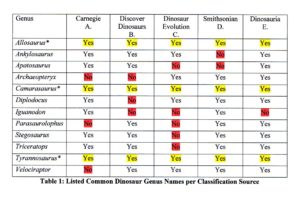 Next, with the three genus names common to all five classification sources (Allosaurus, Camarasaurus, and Tyrannosaurus), I compared how each source classified them.
Next, with the three genus names common to all five classification sources (Allosaurus, Camarasaurus, and Tyrannosaurus), I compared how each source classified them.
A. Carnegie:
1. Allosaurus: Saurischians>Theropods>Allosaurus.
2. Camarasaurus: Saurischians>Sauropodomorphs>Sauropods>Camarasaurus.
3. Tyrannosaurus: Saurischians>Theropods>Tyrannosaurus
B. Discover Dinosaurs:
1. Allosaurus: Saurischians>Theropods>Allosaurus
2. Camarasaurus: Saurischians>Sauropods>Camarasaurus
3. Tyrannosaurus: Saurischians>Theropods>Tyrannosaurus
C. Dinosaur Evolution:
1. Allosaurus: Saurischia>Theropoda>Carnosauria>Allosaurus.
2. Camarasaurus: Saurischia>Sauropoda>Macronaria>Camarasaurus.
3. Tyrannosaurus: Saurischia>Theropoda>Tyrannosauroidea>Tyrannosaurus.
D. Smithsonian:
1. Allosaurus: Saurischia>Theropoda>Avetheropoda>Carnosauria>Allosauridae>Allosaurus.
2. Camarasaurus: Saurischia>Sauropodomorpha>Sauropoda>Neosauropoda >Macronaria>Camarasauridae>Camarasaurus.
3.Tyrannosaurus>Saurischia>Theropoda>Avetheropoda>Coelurosauria>Tyrannosauridae>Tyrannosaurus.
E. Dinosauria:
1. Allosaurus: Ornithoscelida>Theropoda>Neotherapoda>Averostra>Tetanurae>Orionides>Avetheropoda>Allosauridea>Allosauria>Allosaurids [38] >Allosaurus.
2. Camarasaurus: Saurischia>Sauropodomorphs>Plateosauria>Massopoda>Anchisauria>Sauropoda>Eurosauropoda>Neosauropoda>Macronaria>Camarasauromorphs [91] >Camarasaurus.
3. Tyrannosaurus: Ornithoscelida>Theropoda>Neotherapoda>Averostra>Tetanurae>Orionides>Avetheropoda>Coelurosauria>Tyrannoraptora>Tyrannosauroidea>Tyrannosaurids [71] >Tyrannosaurus.
So, what can we conclude, keeping in mind that cladistic analysis always assumes evolution? We can say that the effort for the use of cladistics for some seems to be to try to find evidence that allows for ever smaller clades for each dinosaur type. That makes sense from an evolutionary perspective since if evolution is true there should be close connections for a lot of the different dinosaurs. That is why those paleontologists who name “new” dinosaurs usually have a splitter mentality. Generally, other paleontologists come along later and lump many of the names into a smaller number of clades. Also, the Dinosauria (E.) classification that used 30 to 40 sources could be expected to have many more evolutionary steps to get to the genus level because so many opinions would need to be taken into consideration. It is important for the reader to remember that the secular worldview demands that evolutionists always be devoted to the hunt for those elusive transitional forms. In this study I have learned that secular scientists have proposed a number of different dinosaur classification systems and that indicates to me that their “science” is certainly not settled.
In my next article “Dinosaur Kinds-Part 2,” I will take a look at some creationist results for classifying dinosaurs. Since biblical creationists have a completely different set of presuppositions about reality and history compared to the evolutionists, there should be some considerable differences for their classifications compared to those in this article. We will see.
J.D. Mitchell
Click here to buy my book Guidebook to North American Dinosaurs According to Created Kinds.
